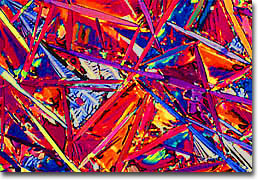|
Minerals are inorganic substances, such as common table salt (sodium chloride or NaCl), that are usually associated with a specific chemical composition and crystalline structure. Naturally occurring elements, such as gold and silver, are also considered minerals. Due to their organic origin, coal, amber, and similar materials are not technically minerals, although they are sometimes labeled as such. Minerals can be differentiated from one another by a variety of means, including color, hardness, cleavage, specific gravity, elasticity, and luminescence, to name just a few. At least 1,500 minerals have been identified, but only about 200 are considered common and only a fraction of these are prevalent enough to be deemed rock-forming minerals. In addition to such distinctions, minerals are often discussed in terms of their class or group, which is based upon their chemical composition. Typically, minerals are divided into 13 to 15 different groups. Most of the rock-forming minerals, such as quartz, biotite, hornblende, feldspar, and olivine, belong to the group known as silicates, compounds that are primarily comprised of silicon and oxygen.

Stannous Chloride
Animals, including humans, require minerals to live and typically consume the important substances through the diet. Biological processes rely heavily on inorganic salts and other minerals to perform many enzymatic and other biochemical functions. Moreover, many enzymes require a cofactor that is metallic in nature. For instance, the oxygen carrying protein hemoglobin contains the coenzyme heme, which contains an iron ion that forms a coordination complex with elemental oxygen. This allows human blood to carry oxygen to all of the cells in the body. Other simple minerals are used by biological systems to provide a "buffer" system in the cytoplasm that avoids hydrogen ion concentration fluctuations. These biological buffers operate naturally to provide a uniform environment in which the body conducts its biochemical housekeeping functions. Heavy metal minerals also play an important role in many enzymatic reactions. The vitamin cyanocobalamine (Vitamin B12), for example, transfers methyl groups to other molecules during routine metabolism. The name cyanocobalamine derives partly from the cobalt ion that is complexed in the central portion of the vitamin. This ion is important in complexing and stabilizing the methyl group before transfer and assisting with the actual transfer.

Magnesium Chloride
Although people may obtain a sufficient amount of minerals to meet their bodily needs through the diet, they do not always do so. The demands of a busy schedule often inspire the habit of eating what is convenient rather than what is healthy. Thus, studies have shown that a surprising number of Americans are deficient in one or more vitamins and minerals. Also contributing to this problem is the fact that foods that were once great stores of these essential nutrients are not as vitamin- and mineral- rich as they once were. Modern farming methods, which typically emphasize the appearance and storability of fruits and vegetables rather than their nutrient content, have played a part in eroding the nutrient content of the produce sold in the average supermarket. Consequently, in order to meet the Recommended Dietary Allowance (RDA) of vitamins and minerals, many people now choose to regularly consume dietary supplements. Yet, the effectiveness of these supplements has frequently been called into question. Indeed, the human body absorbs nutrients from food much better than they do from supplements, and research has shown that much of the vitamin and mineral content of the average supplement is excreted with the urine rather than utilized. Moreover, the Dietary Supplement and Health Education Act of 1994 systematically eradicated most of the Food and Drug Administration's power of overseeing the dietary supplement industry, making it difficult for consumers to validate claims purported by manufacturers of such products.

Nickelous Sulfate
Among the most common mineral deficiencies incurred by the human population are iron, calcium, and iodine deficiencies. Each of these deficiencies may be manifested in various symptoms and also certain diseases. As discussed earlier, iron is necessary for carrying oxygen through the blood as well as the production of red blood cells. If the mineral is not ingested in sufficient quantities, the condition known as anemia may result. Anemia adversely affects bodily functions and causes symptoms that include weakness, fatigue, dizziness, pallor, shortness of breath, and fainting. A deficiency of calcium, on the other hand, typically affects the health of bones and is often associated with the disease osteoporosis. Characterized by reduced bone strength, sufferers of osteoporosis are at increased risk of bone fractures, which can be particularly dangerous to the elderly. Calcium deficiencies can be very serious in children too, however, since inadequate amounts of the nutrient can inhibit growth and adversely impact the teeth. Osteoporosis affects millions of Americans each year, but iodine deficiencies, which cause goiter and plague many parts of the world, have largely been eliminated from the United States and other industrialized nations. This difference in occurrence is a result of the inclusion of iodine in table salt.

Lead Acetate
In addition to animals, minerals are essential to plants, which usually acquire the substances from the soil through their roots. Though it might seem necessary for the inorganic substances to be dissolved in water for this to take place, this is not, in fact, the case. Water and minerals enter plants separately and can do so independently of one another. Minerals can also migrate into plant roots against their concentration gradient through active transport. From the roots, minerals move to the intracellular compartment known as the symplast of epidermal cells and then are transported to the stele, through the plasmodesmata that connect the cells. Moving along this central core of tissue, the minerals can be distributed to all of the various parts of the plant. In order for this to occur, however, the minerals typically must be accompanied by transporter proteins, a system that helps ensure that cells and tissues receive the proper concentrations of the materials. A single plant may contain a great number of various types of transporter proteins, many of which are somewhat specialized for specific minerals and tissues. Transporter proteins also commonly only perform either import or export functions, and regulate their actions by the conditions both inside and outside of cells.
|




